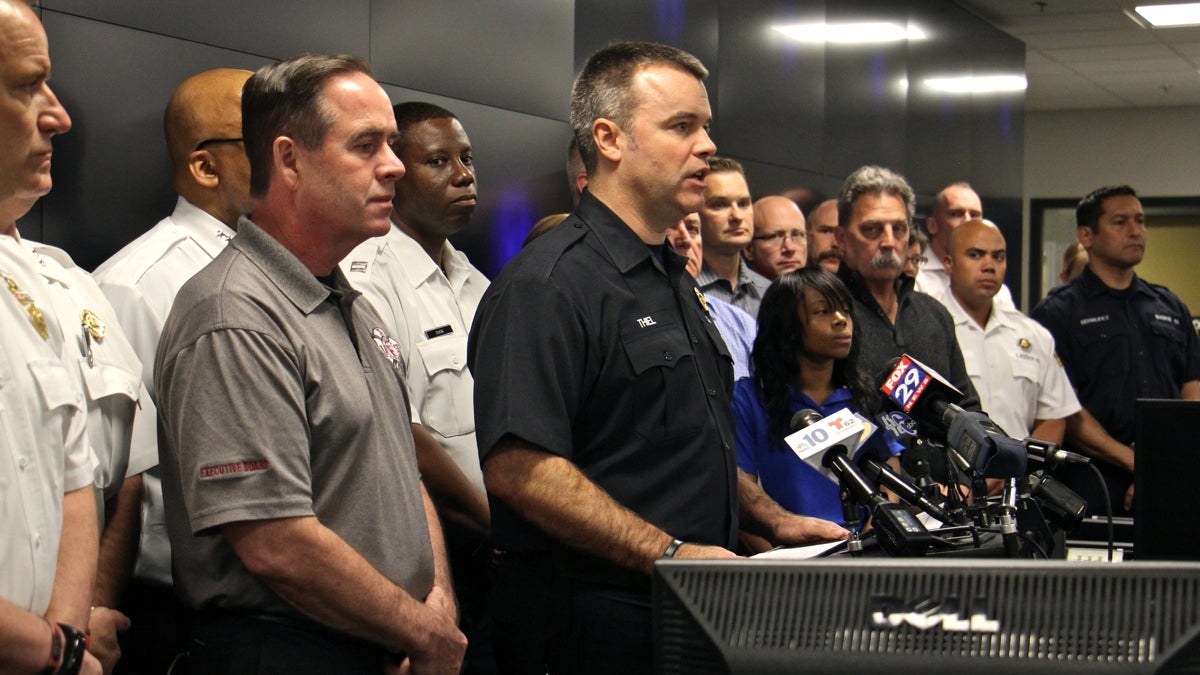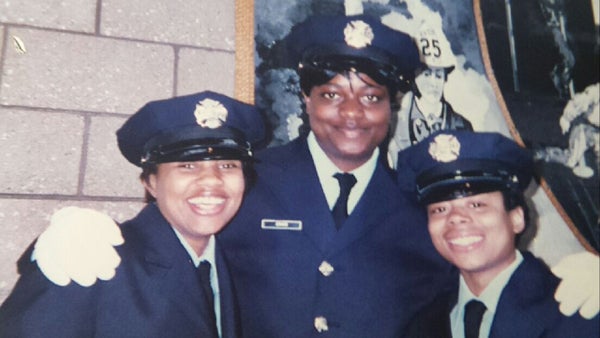Expensive reforms ahead for Philadelphia Fire Department
Listen
Philadelphia Fire Commissioner Adam Thiel speaks about a federal report that blames firefighter errors and faulty gear for the death of Joyce Craig, the first female firefighter to die in the line of duty in Philadelphia. (Emma Lee/WHYY)
One day after federal investigators revealed mistakes that led to a Philadelphia firefighter suffocating in a 2014 house fire, Fire Commissioner Adam Thiel said he supports all the reforms the National Institute for Occupational Safety and Health recommended this week.
He just wonders how many the city can afford.
“Keep in mind we have 63 firehouses, four platoons, and more than 2,600 people in this fire department, so as you can imagine, driving this kind of change, at our scale — it’s going to take time, it’s going to take people,” Thiel told reporters at department headquarters Tuesday morning, several hours before he made his case for increased funding before City Council. “Look, this is gonna be a long-term project, so (it will take) years, there’s just no way around that. A lot of this does depend on resources.”
Investigators with NIOSH’s Fire Fighter Fatality Investigation and Prevention Program revealed all sorts of things that went wrong the night Firefighter Joyce Craig, 37, suffocated in a West Oak Lane house fire — from the late arrival of a backup crew to uncontrolled ventilation to insufficient mayday training. The report also noted that a hose on Craig’s outdated breathing gear burned, stifling her air supply.
Craig’s family has sued the equipment manufacturers for wrongful death, saying she would have survived had her gear not failed.
The NIOSH investigators made 10 recommendations to help the department fix the series of errors that contributed to Craig’s Dec. 9, 2014, death after she got trapped for 13 minutes.
The department already has implemented some, like updating firefighters’ personal safety gear and improving communication at fire scenes by creating a new Field Incident Safety Officer position and stationing battalion chiefs in the dispatch center during incidents.
Others, though, will cost money. Thiel wants to hire 30 more firefighters and four new training officers so that current firefighters will have more time to train. So he’s asking the city to boost the department’s $250 million operating budget by $6.5 million to fund the extra personnel and other improvements.
And some of NIOSH’s recommendations, like making sure firefighters maintain visual, verbal or direct contact while battling blazes, sound good in theory — but don’t always work in practice, Thiel said.
“You can’t see anything in a fire, I mean, this is not a television show. The visibility in a typical fire is zero, you literally cannot see your hand in front of your face,” Thiel said.
Thiel took no issue with anything in the report, acknowledging the errors NIOSH investigators uncovered. Most of what NIOSH found, he added, has already been uncovered by city investigators in a report the city released Monday.
Still, he deflected any suggestion of blame. Fighting fires, especially those in an urban area, is a “dangerous, dirty and complicated” business, and it’s unfair to waste time on Monday-morning quarterbacking, Thiel said.
“It’s dark, it’s raining, it’s smoky, it’s hot, (you) can’t find people,” Thiel said, noting that his department handles, on average, eight structure fires a day. “The outcome was tragic.”
 Firefighter Joyce Craig, who was promoted posthumously to lieutenant (center), posed with fire Lt. Tarra Mungen, (left), and Capt. Lisa Forrest (right) at their Fire Academy graduation in 2004. (Photo provided by Lisa Forrest)
Firefighter Joyce Craig, who was promoted posthumously to lieutenant (center), posed with fire Lt. Tarra Mungen, (left), and Capt. Lisa Forrest (right) at their Fire Academy graduation in 2004. (Photo provided by Lisa Forrest)
Although it’s been more than two years since Craig died, her loss still stings for many firefighters. Fire Capt. Lisa Forrest and Craig went through the Fire Academy together in 2003.
“We were two of 10 women in the fire academy,” Forrest said, smiling as she remembered her friend. “We both had a no-nonsense, get-the-job mentality, so we were drawn to each other from day one.”
Just hours before Craig died, Forrest swapped texts with her, never dreaming it’d be the last time she’d ever hear from her friend. She remembered Craig as “a firefighter’s firefighter who could outwork a lot of men on the job.”
“She had no problem in speaking up when she saw something that wasn’t right,” said Forrest, who heads Club Valiants, the city’s association of black firefighters. “Joyce was always a game-changer.”
Even now, Craig continues to be a game-changer, Forrest said, as the department acts on the lessons learned from her death.
WHYY is your source for fact-based, in-depth journalism and information. As a nonprofit organization, we rely on financial support from readers like you. Please give today.




